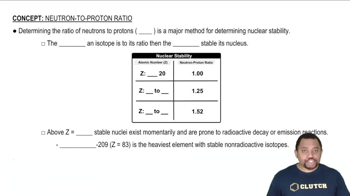Here are the essential concepts you must grasp in order to answer the question correctly.
Radioactive Decay
Radioactive decay is the process by which unstable atomic nuclei lose energy by emitting radiation. This decay occurs at a predictable rate, characterized by the half-life, which is the time required for half of the radioactive substance to decay. Understanding this concept is crucial for determining the age of geological samples through radiometric dating.
Recommended video:
Rate of Radioactive Decay
Uranium-Lead Dating
Uranium-lead dating is a radiometric dating method that uses the decay of uranium isotopes (U-238 and U-235) into stable lead isotopes (Pb-206 and Pb-207) to determine the age of a sample. The ratio of lead to uranium in a sample can indicate how long the decay process has been occurring, allowing scientists to estimate the age of the meteor in this case.
Recommended video:
Electron Capture & Positron Emission Reaction Example
Mass Ratio and Isotope Ratios
The mass ratio of isotopes in a sample provides insight into the relative amounts of each isotope present. In this question, the Pb-206:U-238 mass ratio of 0.855:1.00 indicates the proportion of lead to uranium, which is essential for calculating the age of the meteor. This ratio helps in applying the decay equations to find the time elapsed since the formation of the meteor.
Recommended video:




